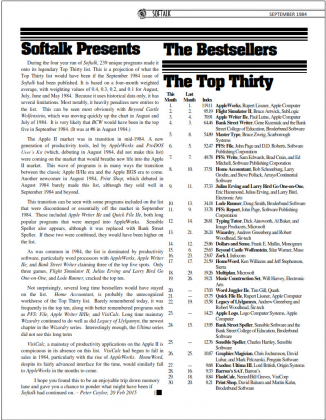I recently had the chance to combine my love for retro computing and Softalk magazine with a "homework" assignment required for a Decision Support Systems class I've been taking. We needed to exercise our skills in model-based forecasting, so I saw a great opportunity to use this assignment to take a much closer look at the time-series of data represented by the famous Top 30 software sales charts at the back of every issue of Softalk (except the first).
As I have time, I'll tell you a bit more about the particulars of the forecast model I made and how it was used to predict the Top 30 list for the imagined "49th issue" of Softalk. In the meantime, below is the text I wrote as the introductory editorial commentary that traditionally wrapped the presentation of the Top 30 list.
Once you have had a chance to savor my "homework" analysis – I've already won a Softalk/FactMiners Data Digger achievement for this contribution – please head on over to The Softalk Apple Project's new GitHub repository where my Excel homework spreadsheet has been morphed into our project's first official topic-specific dataset! :-) Word has it that The Softalk Apple Project and FactMiners will soon launch an official Data Diggers Challenge to see what kind of additional insights folks can gather from digging into this fun bit of micromputing history.
During the four year run of Softalk, 239 unique programs made it onto its legendary Top Thirty list. This is a projection of what the Top Thirty list would have been if the September 1984 issue of Softalk had been published. It is based on a four-month weighted average, with weighting values of 0.4, 0.3, 0.2, and 0.1 for August, July, June and May 1984. Because it uses historical data only, it has several limitations. Most notably, it heavily penalizes new entries to the list. This can be seen most obviously with Beyond Castle Wolfenstein, which was moving quickly up the chart in August and July of 1984. It is very likely that BCW would have been in the top five in September 1984. (It was at #6 in August 1984.)
The Apple II market was in transition in mid-1984. A new generation of productivity tools, led by AppleWorks and ProDOS User’s Kit (which, debuting in August 1984, did not make this list) were coming on the market that would breathe new life into the Apple II market. This wave of programs is in many ways the transition between the classic Apple II/IIe era and the Apple IIGS era to come. Another newcomer in August 1984, Print Shop, which debuted in August 1984 barely made this list, although they sold well in September 1984 and beyond.
This transition can be seen with some programs included on the list that were discontinued or essentially off the market in September 1984. These included Apple Writer IIe and Quick File IIe, both long popular programs that were merged into AppleWorks. Sensible Speller also appears, although it was replaced with Bank Street Speller. If these two were combined, they would have been higher on the list.
As was common in 1984, the list is dominated by productivity software, particularly word processors with AppleWorks, Apple Writer IIe, and Bank Street Writer claiming three of the top five spots. Only three games, Flight Simulator II, Julius Erving and Larry Bird Go One-on-One, and Lode Runner, cracked the top ten.
Not surprisingly, several long time bestsellers would have stayed on the list. Home Accountant, is probably the unrecognized workhorse of the Top Thirty list. Barely remembered today, it was frequently in the top ten, along with better remembered programs such as PFS: File, Apple Writer II/IIe, and VisiCalc. Long time mainstay Wizardry continued to do well as did Legacy of Llylgamyn, the newest chapter in the Wizardry series. Interestingly enough, the Ultima series did not see this long term
VisiCalc, a mainstay of productivity applications on the Apple II is conspicuous in its absence on this list. VisiCalc had begun to fall in sales in 1984, particularly with the rise of AppleWorks. HomeWord, despite its fairly advanced interface for the time, would similarly fall to AppleWorks in the months to come.
I hope you found this to be an enjoyable trip down memory lane and gave you a chance to ponder what might have been if Softalk had continued on.

Recent comments